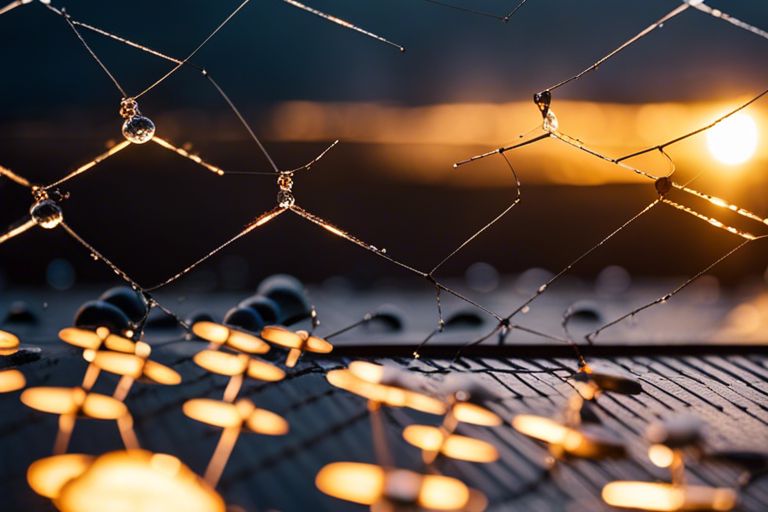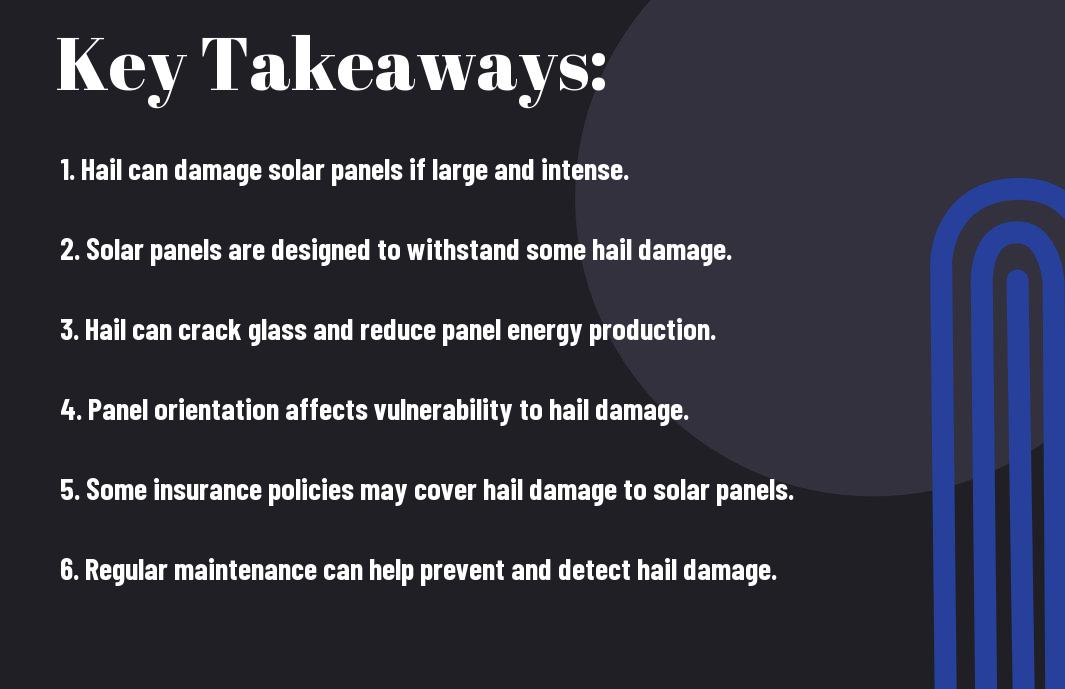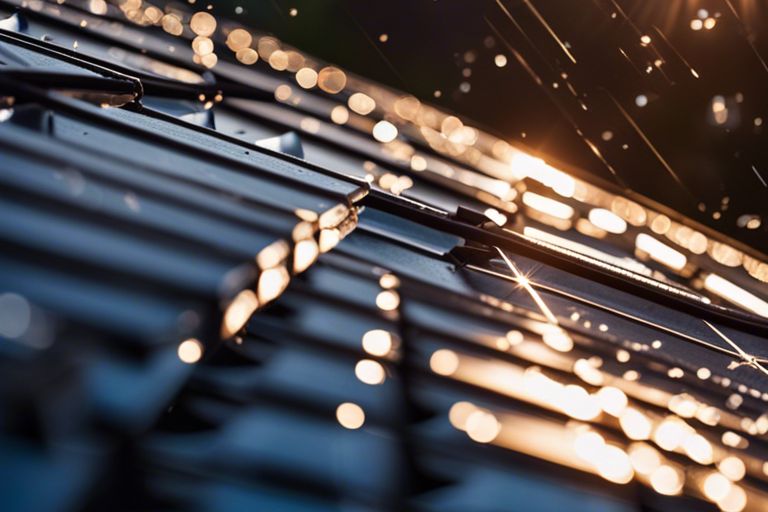It’s a fascinating question to ponder – will hail damage your solar panels? As you investigate into the world of solar energy, you may wonder how resilient these panels are to the forces of nature, including hailstorms. In this blog post, we will explore the potential risks and protective measures you can take to safeguard your solar investment against hail damage.

Key Takeaways:
- Solar panels are durable: Solar panels are designed to withstand various weather conditions, including hail.
- Hail damage is rare: While hail can cause damage to solar panels, occurrences of significant damage are relatively rare.
- Insurance coverage is available: Many solar panel installations come with warranties that cover hail damage, and homeowners insurance policies typically cover damage to solar panels as well.

What is Hail Damage?
A devastating weather phenomenon, hail damage occurs when hailstones, which are balls of ice, fall from the sky during a thunderstorm. These hailstones can range in size from small pellets to large chunks, and the impact they create can cause damage to various objects, including vehicles, roofs, and solar panels.
Definition of Hail Damage
For a better understanding, hail damage refers to the destruction or harm caused by hailstones hitting an object. When hailstones fall from the sky, they can strike with significant force, leading to dents, cracks, or even shattered surfaces.
Types of Hail Damage
To comprehend the types of hail damage, you must know that hail can cause various forms of destruction, including:
| Dents | Cracks |
| Shattered surfaces | Loosened components |
| Water leaks | Reduced efficiency |
- Assume that solar panels have dents or cracks, their performance may be compromised.
- Importantly, water leaks can lead to further damage and reduce the efficiency of the solar panels.
How Solar Panels Work
Photovoltaic Cells
Solar panels work by harnessing the power of the sun through photovoltaic cells. These cells are made of semiconductor materials, such as silicon, that convert sunlight into direct current (DC) electricity.
Energy Conversion Process
With the help of an inverter, the DC electricity generated by the photovoltaic cells is converted into alternating current (AC) electricity, which is the type of electricity used in homes and businesses. This energy can then be used to power your appliances and electronics, reducing your reliance on the grid and lowering your electricity bills.
The energy conversion process is crucial in making solar panels an efficient and sustainable energy source. By converting sunlight into electricity that can be easily used in your daily life, solar panels play a key role in reducing carbon emissions and combating climate change.
Can Hail Damage Solar Panels?
Once again, you find yourself wondering about the potential risks of hail damaging your solar panels. Hail can indeed pose a threat to your solar panel system, but understanding the factors that affect the damage can help you assess the level of risk.
Potential Risks
Hail: Hailstorms can cause physical damage to solar panels, including cracks or breaks in the glass covering, which can affect the performance of the panels. In severe cases, hail can even puncture the panels, leading to more extensive damage.
Factors Affecting Damage
Affecting: The severity of hail damage to solar panels can vary depending on factors such as the size and speed of the hailstones, the angle at which they hit the panels, and the quality of the panel materials. To assess the risk of hail damage to your solar panels, consider the following factors:
- The size of the hailstones
- The speed of the hailstorm
- The angle at which the hailstones hit the panels
Though hail can pose a threat to your solar panels, taking preventive measures such as installing hail-resistant panels or protective covers can help minimize the risk of damage and protect your solar investment in the long run.
Types of Solar Panels and Hail Resistance
To determine the hail resistance of solar panels, it’s imperative to understand the types of solar panels available in the market. Each type has its own level of durability when it comes to hail damage. Below, you will find information about the three main types of solar panels and their ability to withstand hailstorms.
| Monocrystalline Silicon Panels | Polycrystalline Silicon Panels |
|---|---|
Monocrystalline Silicon Panels
Solar panels made of monocrystalline silicon are known for their high efficiency and durability. These panels are made from single-crystal silicon, which makes them more resistant to hail damage compared to other types. The dense structure of monocrystalline silicon panels allows them to withstand moderate hailstorms without significant impact on their performance. Recognizing the durability of these panels can give you peace of mind knowing that your solar system is protected in extreme weather conditions.
Polycrystalline Silicon Panels
One of the most commonly used types of solar panels is polycrystalline silicon panels. These panels are made from multiple silicon crystals, which makes them slightly less efficient but more cost-effective. While polycrystalline silicon panels are durable, they may not be as hail-resistant as monocrystalline silicon panels. However, advancements in technology have improved the durability of polycrystalline panels, making them a reliable option for your solar energy needs.
Hail storms can pose a threat to solar panels, especially if they are not properly protected. However, with advancements in technology and design, solar panels have become more resilient to hail damage. When choosing the right solar panels for your home or business, it’s imperative to consider the hail resistance of the panels to ensure they can withstand extreme weather conditions.
Thin-Film Panels
For those looking for a more flexible and lightweight option, thin-film solar panels are a popular choice. These panels are made by depositing a thin layer of photovoltaic material onto a substrate, such as glass or metal. While thin-film panels are less efficient than crystalline silicon panels, they are more resistant to hail damage due to their flexible and durable design. This makes them a suitable option for areas prone to hailstorms.
Silicon plays a crucial role in the composition of solar panels, affecting their durability and resilience to external factors like hail. Understanding the different types of solar panels and their hail resistance can help you make an informed decision when purchasing a solar system for your property. It’s imperative to consider your location and the likelihood of hailstorms to ensure your solar panels can withstand any potential damage.
Real-Life Examples of Hail Damage to Solar Panels
Despite the durability of solar panels, they are not completely immune to the forces of nature. One common concern for solar panel owners is the potential for hail damage, especially in regions prone to severe weather conditions. Here are some real-life examples to illustrate the impacts of hail on solar panels.
Severity of Damage
Solar panels can sustain varying degrees of damage from hail, depending on the size and intensity of the hailstones. In some cases, hail can cause small cracks or chips on the surface of the panels, affecting their efficiency over time. However, in more severe instances, larger hailstones can shatter the glass covering of the panels, leading to significant impairment of their performance.
Cost of Repairs or Replacement
Examples of the cost of repairing or replacing hail-damaged solar panels can range from a few hundred to several thousand dollars, depending on the extent of the damage and the type of insurance coverage you have. It is crucial to assess the damage promptly and consult with a professional to determine the best course of action for restoring your solar energy system.

Preventative Measures and Maintenance
Regular Inspections
For the longevity and optimal performance of your solar panels, it’s important to conduct regular inspections. You should check for any signs of damage, such as cracks or dents caused by hail, as well as loose connections or debris buildup.
Cleaning and Debris Removal
Cleaning your solar panels regularly is crucial to ensure they continue to operate efficiently. Dust, dirt, bird droppings, and debris can accumulate on the panels, blocking sunlight and reducing their energy output.
Removal of debris is also important as it can create shadows on the panels, impacting their overall performance. Make sure to clear any leaves, branches, or other objects that may be obstructing sunlight from reaching the panels.
Protective Coatings and Covers
The application of protective coatings or covers can help safeguard your solar panels from potential damage, including hail impact. These additional layers can provide an extra level of defense against weather elements and debris, prolonging the lifespan of your panels.
To further protect your investment, consider investing in hail-resistant panels that are specifically designed to withstand severe weather conditions. These advanced panels are engineered to endure hailstorms without sustaining significant damage, giving you peace of mind during extreme weather events.
To wrap up
Ultimately, hail can potentially damage solar panels, depending on the size and intensity of the hailstones. While solar panels are designed to withstand various weather conditions, including some hail impacts, larger hailstones could cause cracks or dents that may affect their performance over time. It is important to consider the risk of hail damage when installing solar panels and to take precautions to mitigate any potential issues.
Q: Can hail damage solar panels?
A: Yes, hail can potentially damage solar panels if the hailstones are large and hit the panels with enough force.
Q: How common is hail damage to solar panels?
A: Hail damage to solar panels is relatively rare, as most solar panels are designed to withstand moderate hailstorms.
Q: What factors determine if hail will damage solar panels?
A: Factors such as the size and density of the hailstones, the angle of impact, and the quality of the solar panels can determine if hail will cause damage.
Q: How can I protect my solar panels from hail damage?
A: You can protect your solar panels from hail damage by installing hail-resistant panels, adding protective covers, or seeking insurance coverage that includes hail damage protection.
Q: What should I do if my solar panels are damaged by hail?
A: If your solar panels are damaged by hail, you should contact your solar panel provider or insurance company to assess the damage and determine the best course of action for repair or replacement.
